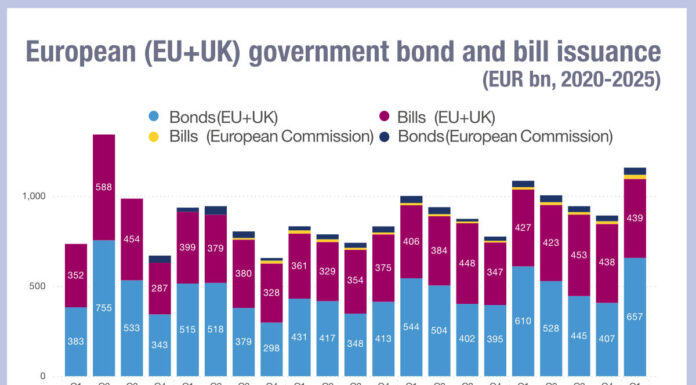
The hybrid approach in fixed income brokerage – How brokers better comply with clients’ execution models.
Umberto Menconi, head of Digital Markets Structures, Market Hub, Banca IMI, Intesa Sanpaolo Group
Unlike equities, the fixed income market has traditionally very much been a broker-dealer-led business operating on two levels: the primary and secondary markets.
A fixed income broker-dealer is a trader who executes security trades on behalf of institutional and/or retail clients, based upon several decision-making tools such as research, trading analytics, market data analysis and portfolio-risk monitoring.
The high fragmentation of the bond markets, the complexity and illiquidity of some instruments and the lack of clean data has hindered its full automation, creating disparities with the equity and forex worlds, with traders often favouring the voice channel over the electronic one.
In recent years, the digitalisation process has changed investor behaviour and market infrastructure, and has consequently reshaped the brokers’ role and business model in order to better comply with clients’ more sophisticated ‘execution models’ and to improve liquidity search, and price discovery. Today, the rise of electronic trading in fixed income reaches to near 80% of daily trades; although this percentage represents only 45% of total market volumes, because larger size orders are still mostly traded via voice.
The majority of European fixed income trades are carried out on few large trading venues, operating on a request for a quote (RFQ) basis, where the buy side can ask for quotes from a number of liquidity providers, thus satisfying their best execution requirements
Settlement is in most cases bilateral, and firms must have a multiple secondary agreement in place with each prospective broker-dealer. Therefore, the more dealers a firm connects to, the more secondary clearing agreements it must put in place, which increases buy-in risk.
It is a different story when we consider the retail flow business. Regulated markets such as Borsa Italiana’s MOT or EuroTLX can provide a different liquidity source and full transparency to retail investors, through different protocols and market models such as central limit order book (CLOB) and all-to-all. Settlement in these cases is via a central counterparty clearing house (CCP).
During the pandemic, new record volumes were recorded on electronic platforms in fixed income markets, which has accelerated the shift of liquidity towards electronic trading venues, while market competition and technological innovation are exacerbating the search for new platform functionalities such as portfolio trading, auto-execution tools, axes dissemination, and liquidity aggregations, in order to capture the low touch business in a more efficient way.
Electronic trading has tended to have a positive impact in terms of market quality, especially for assets that were already liquid by increasing competition, broadening market access and reducing the dependence on traditional trading workflows. But, it does not always represent the appropriate solution for all securities trades, especially for illiquid ones where the risk of information leakage is high and for which the role of bilateral dealer-client relationships is still centric, because that model may better respond to crises generated by periods of high volatility.
The ability to give customers flexibility and choice in terms of price discovery, execution model and processing of their transactions, through voice, hybrid, or fully electronic brokerage options (and to manage hybrid models composed of voice and electronic, and low touch and high touch business), represent real challenges for fixed income brokers. So do the ability to build strong partnerships with vendors on one side and with clients on the other, the understanding of the changes in clients’ businesses, and the ability to reshape the service.
To provide more transparency and reduce over-the-counter (OTC) trading, MiFID II created two new execution venues: the OTF (organised trading facility) and the SI (systematic internaliser) and fixed income brokers may also rely on these new liquidity pools. OTFs and SIs are still mostly based on chat/voice, but technology is supporting their transformation towards automation. In particular, communication networks are rapidly improving and now there is a very thin barrier between those digital networks and multilateral trading venues. To reduce operational risk and time to answer, to increase efficiency and quality of trading and to improve the client affiliation experience, some banks have promoted direct connectivity, with a proprietary API, to their main clients to replace voice channel and chats.
Direct connectivity is expensive, because it is unique for each client and so it is difficult to offer to multiple clients. For this reason, direct connectivity with buy-side bond desks should work together with liquidity provision on multilateral trading platforms, depending on client need. The buy side, in the case of direct connectivity, must implement a best execution process that is more sophisticated than the multiple RFQs (via transaction cost analysis for example) to justify single requests, and the sell side should provide data to support buy-side analysis.
The key is to develop a flexible business model through a balanced blend of high and low touch, multilateral venues and SIs, the right mix of human and digital working in order to meet and exceed client expectations. The complexity of new execution protocols and multi-asset trading means it needs to re-evaluate the available technology. In particular, the access to an exponential amount of data and its complexity makes it almost impossible to understand properly. Hence the need to develop applications that extract and analyse information. The buy side can take advantage by this flexible execution policies which can aggregate several markets, protocols, and market models in only one execution strategy in a sort of client services hub, where the order transmission and execution is driven by best execution criteria and where brokers support clients differently in consideration of their orders, showing a well-balanced approach.
Monitoring of trading costs, orders, best execution and quality of execution have been the most significant drivers for the process development of fixed income electronification. Removing time-consuming manual work from easier trades can free up a significant amount of a trader’s time to focus on more difficult trades that require more client interaction, thus reducing the possibility of human error, especially with illiquid and difficult-to-price markets.
Nevertheless, technological innovation and the increasing competitiveness of financial markets may create high barriers to entry. One of the possible solutions is the outsourcing of some services to guarantee the appropriate technological flexibility.
In the end, the key points for a fixed income agency broker is to be able to offer multiple means of execution and multiple liquidity pools, including a hybrid voice and electronic broking model for pre-trade, trade and post-trade services in a multi-asset space, in order to provide comprehensive solutions that are tailored to the client (recognition of the difference between B2B and B2B2C needs is essential) and appropriate order types.
©Markets Media Europe 2025

























